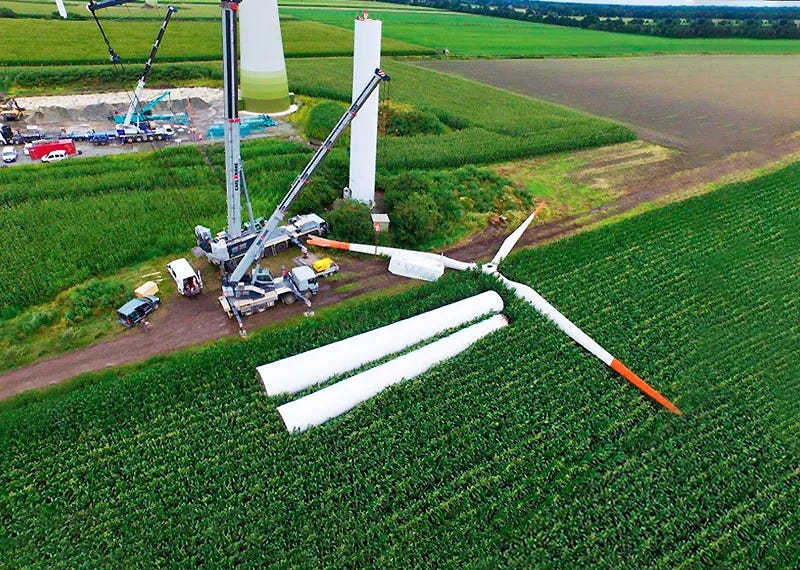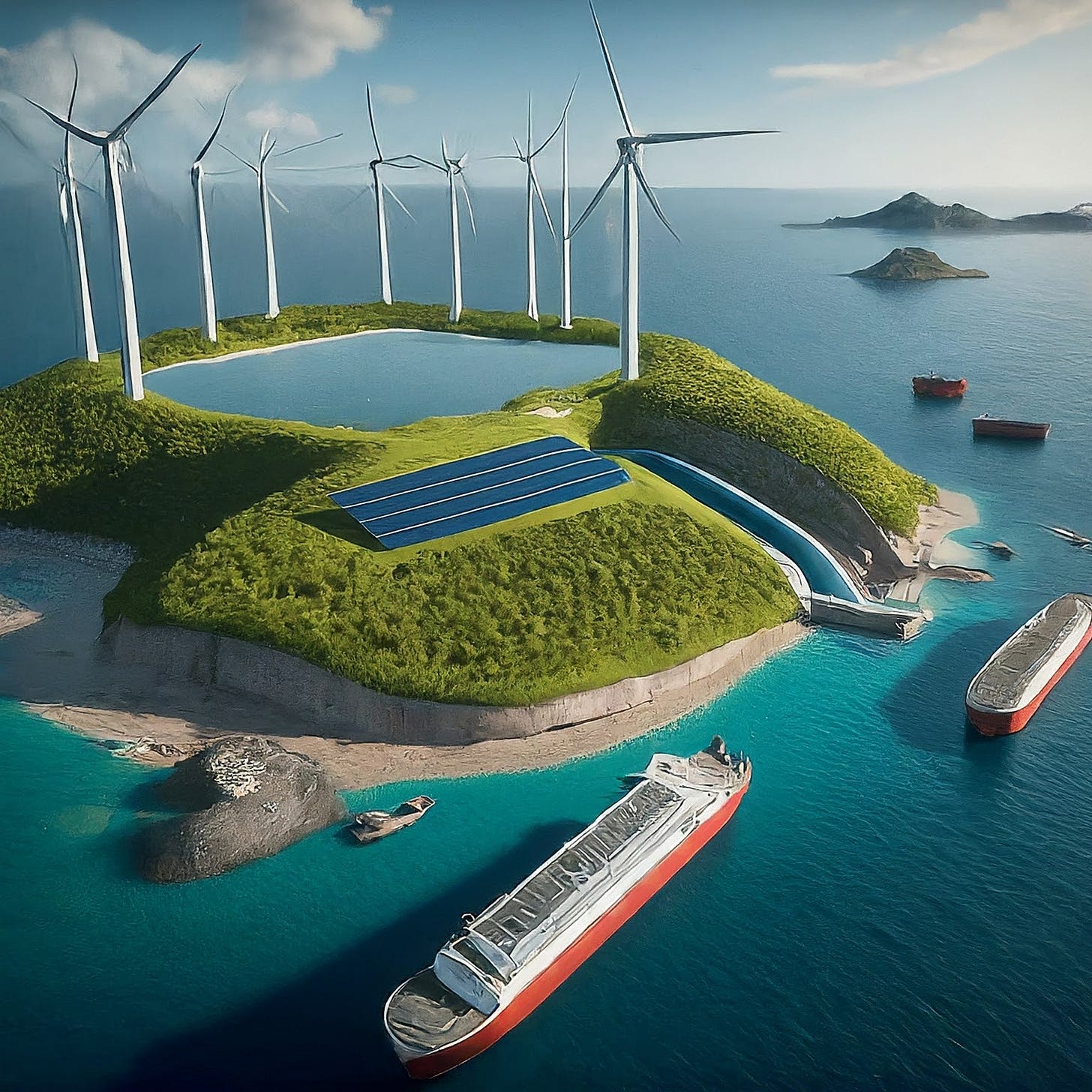No Island is an Island: Part 2
So what if an island could be powered 100% by renewables?
Lots of places have declared vacuous “Climate Emergencies” - so far not many have declared “Energy Emergencies”. One that has is the Spanish Canary Islands; which is odd because this is also the home of the closest thing we have to a Net-Zero Demonstration Project.
In Part 1 of No Island is an Island, I wrote about the way in which going “off-grid” is a fantasy. Essential parts of the off-grid lifestyle come from our deeply integrated on-grid industry and manufacturing. So whilst individuals can pretend to go off-grid, their ability to do so and survive, is predicated on our integrated energy, technology and manufacturing based economy. If we scale-up this thought experiment, we can start to see how an apparently successful “demonstration project” of an all renewables-system is also only possible due to the “on-grid” integrated energy, technology and manufacturing based economy.
Demonstration Project
The island of El Hierro in the Canary Islands and has a population of c. 11,000. In about 2010, an electricity generating system was installed, coupling wind turbines with pumped-storage. The nameplate wind “capacity” was double the island’s peak electricity demand leading to excess electricity generation on some days. This excess is used to pump water uphill for reservoir storage and subsequent electricity-generation when the wind drops. Pumped-Hydro being the only kind of “battery” that can realistically store “grid-scale” elctrons.
In many ways this is an ideal test-case for a self-contained, sustainable renewable energy system. The Canary Islands are famously windy, attracting generations of wind-surf and kite-surf enthusiasts. The geography lends itself to pumped-hydro, and being an island – there are known boundary conditions. Indeed, just recently (December 2023) it was reported that El Hierro had run on the hydro-wind combination for 28 consecutive days - which is impressive in itself.
The project is of course over-hyped and badly mis-represented by the press. As early as 2015, it was touted as being a successful demonstration of 100% renewables.
Unfortunately for the enthusiastic headline writers, this configuration required diesel-fuelled generation for over 50% of the time on an annual basis. The most recent data (for 2023) is no better:
The percent of electricity for the island supplied by the wind/storage system for the full year was 35%. The other 65% came from the backup diesel generator. The best month for the wind/storage system was July, when it supplied 62% of the island’s electricity. But then there was October, when it only supplied 10%. (The Manhattan Contrarian)
In addition, it is always worth noting that electricity is a fraction of total energy needs in any modern system (usually about 20% of the total).
That said, one could argue that both of these challenges could be “fixed”.
Firstly, by a serious capacity increase of the wind (and solar) and pumped-hydro – such that no diesel back-up is ever required (the famous “over build” hypothesis).
Secondly, “electrification of everything” would push electricity from 20% of total energy to c. 100% of energy needs (and reduce the primary energy requirements in the process). This of course would require vastly more “over-building” of generation and storage – but, on paper, one can see how this could be achieved if sufficient funding and land was found.
This would be a massive achievement, even for an island of 11,000 people – and for many people it would be Proof!! of how a “100% renewable, sustainable society” can be achieved. A milestone on the inevitable road to global Net Zero.
Sadly, it would be no such thing.
Such an amazing “Demonstration Project” achieved today, would simply be a demonstration that a local and isolated economy can be powered by renewables BUT would tell us nothing about how this would scale to anything meaningful at the global level.
Ad Infinitum
Why so Dr Doom? Well, simply put – and with reference to the discussion on the humble pencil in Part 1 of this post, an island isn’t really an island: it is simply a geographically isolated part of a massive global industrial complex.
None of the concrete, steel, fiberglass, copper etc used in the hydro-wind infrastructure comes from the island, nor the engineers who design and manufacture the wind turbines and hydro pumps, nor the geologists who have found the mines, nor the professors who taught the geology students, nor the installation and maintenance equipment and personnel, nor the ships who bring the materials to the island, nor the people who make those ships, nor the fuel used in all these steps, nor the food that feeds all the people all the way down the complex chain to the copper miners in Peru, the people who make the polysilicon and so on ad infinitum…
None of this has been supported by the “sustainable and renewable” energy created and used on the island. As a poor analogy to business - one could think of this as the hydro-wind covering the Island’s (energy) operating expenses, but does nothing to address the (energy) capital required to ensure the perennity of the business. You might argue that having your OPEX covered is a great place to be - but hold that thought for a moment.
Replaceable not Renewable
In a logical extension of the thought experiment, one could ask where the next-generation of wind and solar harvesting machines will come from? In other words, the massive build of wind, solar and pumped hydro might be able to support the energy needs of the island on a day-to-day and indeed, annual basis. But there would not be enough excess energy to build the inevitable next generation of wind and solar harvesting machines and maintain the pumped-hydro facilities.
Wind turbines, solar panels, batteries, pipes and pumps have to come from somewhere, and will require enormous amounts of energy to manufacture, transport and install. The Island Project might have 100% renewable energy one day, but it certainly is not sustainable in the sense of being self-perpetuating. To be truly sustainable you would need to generate significantly more than 100% of the island’s running needs to have sufficient energy to power all the mining and manufacturing.
I have no idea what that number would be, but it follows that if you build vastly more energy-gathering infrastructure, the energy required to replace all those machines goes up, and so yet more is needed…
And herein lies the conundrum of scaling from an island of 11,000 to a global system. It is a bit of a cliche to say that solar panels are built using coal (and transported and installed using oil), but nonetheless it is true.
The ability of an island like El Hierro to become self-sufficient in its electricity needs is predicated on the rest of the global economy which uses 84% fossil fuels (and probably >95% in the critical areas like mining, processing, manufacturing and transport).
So in the same way an “off-grid” influencer uses tools, fertilizers and technology, so an island demonstration project is only possible because of the industrial/energy ecosystem that it is puporting to obviate.
So how did we get here?
As a criticism of my Island example, one could argue that the energy transition is a global affair and that all of the above would be achievable as wind, water and solar are rolled out at massive scale and simply replace hydrocarbons as the energy input – the complex edifice of modern industrial society will simply continue as before just with a different (low carbon) energy input.
“The world that we’ll have in 2050 is extremely similar to the one we have now. We will still be flying, we’ll still be eating meat, we will still be warming our homes, just heating them differently,” he said. “The lifestyle change that goes with this is not enormous at all.” Chris Stark, exiting CEO of the UK’s Climate Change Committee April 2024.
This kind of statement is easy-to-say and it is an attractive intellectual short-cut. It is becoming increasingly politically necessary as people start to realize that Greener and Cheaper was a lie…
However, many regular readers will have already understood that this post about El Hierro is really just looking at the problem through the lens of “Surplus Energy” and Energy Return on (Energy) Investment (“EROI”/”EROEI”).
As with LCOE, so with EROI and headline-grabbing demonstration projects - the devil is in the detail, or more specifically in the boundary conditions.
If we want to believe that an isolated island can be a reasonable proxy for our Brave New World, then we must consider what is included within the boundary of the island and what is not included: respectively generation and useage (within) and the entire techno-industrial society that provides all the machinery needed for the “renewable” energy system (external). Studying the energy system of an island makes this internal-external contrast painfully obvious.
Cheap energy is a fundamental input into society because it allows lots of work to get done for little cost - and here the cost is not necessarily in monetary terms - but it is the cost of energy needed to get more energy. You have to use energy to get energy - this can be illustrated by thinking about food as primary energy - but the same applies to the whole of society. The more industrialized we are, the more surplus energy we need to maintain our complex systems.
The Surplus Energy Paradox: Renewable energy requires a complex industrial system to magic it into existence, and that complex industrial system needs vast amounts of surplus energy - something renewable energy itself can’t provide.
Ultimately, a small island might be able to have an electricity system that is 100% wind-water-solar. But even if this is achieved, in no way would it be a “Demonstration-Project” for global Net Zero ambitions.






Excellent article. I would have thought they would have used a lot more solar, instead of all that wind. I would imagine the island has a good solar resource.
Manhattan contrarian also did a piece on a South Korean island of Gapa that tried to be 100% renewable with 174kwpk solar, 250kwpk wind & 3.9MWh of battery storage to supply their 230kw peak demand, 142kw avg demand. But they have also failed in their goal, achieving typically around 40% of their demand. Very expensive electricity.
https://www.manhattancontrarian.com/blog/2016/8/16/how-much-do-the-climate-crusaders-plan-to-raise-your-cost-of-electricity
There's a couple of places in Australia that tried go totally renewable. One of them is King Island which is a very windy place but no matter what they tried they couldn't get rid of the diesel generators. Then there was Alice Springs which is sited in the middle of a very sunny desert and is very isolated. Again they couldn't do without the diesel generators and as well suffered numerous blackouts when passing clouds tripped the whole system.